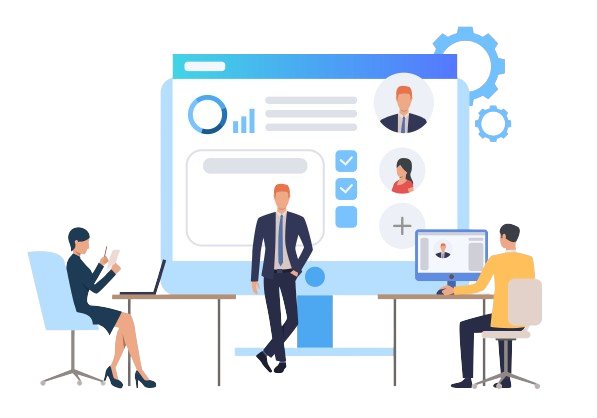
Human Resource Management (HRM) is a critical component of organizational fulfillment, encompassing many features that revolve around handling an enterprise’s most precious asset – human beings. This blog will delve into the foundations and capabilities of HRM, exploring its evolution, essential additives, and the pivotal role it plays in present-day companies.
Historical Evolution of HRM
The ancient evolution of Human Resource Management (HRM) strains a transformative adventure from traditional personnel management to a strategic and crucial aspect of organizational success. We are initially focusing on administrative tasks like payroll, the idea, and step-by-step, spotting the pivotal function of human capital in attaining enterprise goals.
This transition stated the need for a more significant strategic method of handling employees, leading to the emergence of HRM. Over time, HRM has advanced from a mere assist feature to a dynamic subject actively contributing to strategic decision-making, emphasizing aligning human assets with overall organizational goals.
Key Components of HRM
Human Resource Management (HRM) accommodates several vital components that contribute to the robust control and development of a company’s body of workers. These components play an essential role in attracting, retaining, and optimizing the overall performance of employees. Here are the important thing components of HRM:
1. Recruitment and Selection
- Identifying workforce needs.
- Creating job descriptions and specifications.
- Recruiting suitable candidates.
- Conducting interviews and assessments.
- Selecting and hiring the right individuals.
2. Training and Development
- Assessing employee skills and identifying training needs.
- Designing and implementing training programs.
- Providing opportunities for skill development and career growth.
- Continuous learning initiatives to keep employees updated.
3. Performance Management
- Setting performance expectations and goals.
- Regular performance evaluations and feedback.
- Recognition of achievements and addressing performance issues.
- Developing performance improvement plans.
4. Compensation and Benefits
- Designing and managing compensation structures.
- Administering employee benefits (healthcare, retirement plans, etc.).
- Ensuring competitive and fair compensation within industry standards.
- Managing payroll and related processes.
5. Employee Relations
- Establishing and maintaining positive relationships between employees and the organization.
- Addressing workplace conflicts and grievances.
- Promoting a positive work culture and employee engagement.
- Facilitating effective communication within the organization.
6. Legal Compliance
- Ensuring adherence to labor laws and regulations.
- Managing diversity and equal opportunity in the workplace.
- Handling legal aspects related to employment contracts and terminations.
- Staying informed about changes in employment laws.
7. Health and Safety
- Creating and enforcing workplace safety policies.
- Implementing health and safety training programs.
- Compliance with occupational health and safety regulations.
- Handling workplace incidents and ensuring employee well-being.
8. Strategic HR Planning
- Aligning HR practices with organizational goals.
- Forecasting workforce needs based on business objectives.
- Succession planning for key roles.
- Strategic workforce planning to adapt to changing business environments.
9. Employee Engagement
- Developing initiatives to enhance job satisfaction.
- Employee feedback mechanisms and surveys.
- Promoting a positive organizational culture.
- Recognizing and rewarding employee contributions.
10. Talent Management
- Identifying high-potential employees.
- Succession planning for key positions.
- Developing strategies for attracting and retaining top talent.
- Nurturing a culture of continuous talent development.
These components collectively form the foundation of HRM, emphasizing the strategic and people-centric nature of managing human sources inside a company. A nicely included HRM device contributes drastically to the overall fulfillment and sustainability of the business.
The Strategic Role of HRM
The strategic position of Human Resource Management (HRM) has developed appreciably, transforming it from a traditional administrative characteristic to an essential strategic accomplice in attaining organizational desires. Here’s an exploration of the strategic position of HRM and its impact on common commercial enterprise fulfillment:
1. Alignment with Organizational Goals
Strategic Human Resource Management(HRM) includes aligning human aid practices with the broader dreams and goals of the organization. HR specialists work carefully with leadership to apprehend enterprise strategies and ensure that HR initiatives guide and enhance these strategies.
2. Talent Acquisition and Retention
Human Resource Management(HRM) is pivotal in attracting, choosing, and keeping top expertise. By understanding the employer’s strategic needs, HR professionals can implement centered recruitment strategies and create a place that fosters employee loyalty and longevity.
3. Workforce Planning
Strategic HR planning includes forecasting future staff needs based on the organization’s strategic targets. This includes figuring out critical competencies, planning for succession, and ensuring the proper skills are needed to satisfy evolving business requirements.
4. Change Management
As groups undergo adjustments, whether because of technological improvements or shifts within the commercial enterprise landscape, Human Resource Management(HRM) is instrumental in managing the human aspect of change. This consists of facilitating communique, addressing worries, and ensuring a smooth transition for employees.
5. Leadership Development
Developing a strong leadership pipeline is a strategic imperative for Human Resource Management(HRM). This involves identifying and nurturing excessive potential employees, offering management development applications, and ensuring the company has successful leaders to force its strategic vision.
6. Employee Performance and Productivity
Strategic Human Resource Management(HRM) specializes in improving workers’ overall performance to contribute without delay to organizational fulfillment. This includes enforcing performance management systems, putting clean expectancies, and offering comments and improvement possibilities.
7. Culture and Employee Engagement
HRM contributes to shaping and retaining the organizational tradition. A fantastic and aligned way of life fosters worker engagement, which, in turn, affects productiveness, innovation, and the capability to draw and maintain expertise.
8. Strategic Compensation and Benefits
Aligning reimbursement and advantages with the organizational approach is a crucial obligation of Human Resource Management(HRM). This involves designing reward systems that encourage personnel to contribute to strategic goals and ensuring that compensation practices are competitive in the enterprise.
9. Data-Driven Decision-Making
Strategic Human Resource Management(HRM) leverages statistics and analytics to make informed selections. HR professionals use metrics to evaluate the effect of HR tasks, pick out trends, and offer insights that contribute to strategic selection-making on the organizational degree.
10. Global Talent Management
Strategic Human Resource Management(HRM) extends beyond borders in increasingly globalized commercial enterprise surroundings. Managing various personnel, understanding cultural nuances, and implementing worldwide skills strategies are essential elements of the strategic function of HRM.
In essence, the strategic role of HRM includes integrating human resource management practices with the overarching dreams of the company. By doing so, HRM becomes a proactive accomplice in driving commercial enterprise achievement, contributing to competitiveness, innovation, and lengthy-term sustainability. This strategic method positions HRM as a crucial function beyond traditional administrative tasks to shape and actively help the company’s future.
Please Write Our Latest Blog: Top 10 eCommerce Business Models in 2024
Challenges and Trends in HRM
Human Resource Management (HRM) is a dynamic area that continuously evolves to fulfill the challenges posed by using changing place of job dynamics and consists of rising trends to stay relevant. Here are a number of the vital things demanding situations and developments in HRM:
Challenges
1. Technology Integration: Rapid technological improvements require HR experts to conform to new gear for recruitment, schooling, and performance management.
2. Remote Work and Flexibility: Managing faraway teams offers demanding communication, worker engagement, and productivity situations.
3. Diversity and Inclusion: Fostering a numerous and inclusive place of job calls for overcoming biases, selling equal possibilities, and addressing discrimination-related issues.
4. Employee Well-being: Balancing workloads, coping with strain, and promoting mental health emerge as vital demanding situations, especially with multiplied attention to the importance of employee well-being.
5. Changing Workforce Dynamics: Human Resource Management(HRM) wishes to conform to converting demographics, including the rise of the gig economy, the multi-generational body of workers, and numerous worker expectations.
6. Skills Gap: Identifying and addressing ability gaps in the staff is essential to satisfy the needs of evolving job roles and rising technologies.
7. Globalization: Managing HR practices globally involves navigating numerous cultures, prison frameworks, and employment rules.
8. Regulatory Compliance: Staying compliant with ever-converting hard work legal guidelines and guidelines poses a non-stop mission for HR specialists.
Trends
1. Artificial Intelligence (AI) and Automation: Artificial intelligence(AI) is increasingly used for obligations with resume screening, chatbots for HR guides, and predictive analytics for staff planning.
2. Remote Work and Hybrid Models: Adopting far-flung work is likely to persist, with many corporations exploring hybrid fashions that combine workplace and remote paintings.
3. Employee Experience: Focus on developing a practical worker experience, encompassing factors like onboarding, expert improvement, and work-life balance.
4. Data Analytics for HR: We leverage facts analytics to make knowledgeable decisions regarding recruitment, performance, and worker engagement.
5. Upskilling and Reskilling: With the rapid pace of technological advancements, there’s an expanded emphasis on continuously gaining knowledge and developing skills to deal with ability gaps.
6. Well-being Programs: Organizations are investing in nicely-being packages, along with intellectual fitness tasks, fitness, and strain control, to aid employee fitness.
7. Flexible Benefits: Personalized and bendy advantage applications that cater to character employee needs and choices.
8. Environmental, Social, and Governance (ESG) Initiatives: Increasing recognition of ESG elements, which include company social responsibility, variety, and moral business practices.
9. Agile HR Practices: We are adopting agile methodologies in HR tactics to decorate adaptability and responsiveness to changing business desires.
10. Collaborative Tools: The use of collaborative gear and platforms for seamless communication and teamwork, particularly in dispensed or remote painting settings.
Understanding and addressing these demanding situations while staying abreast of rising traits allows HR experts to contribute to their groups’ achievement and sustainability proactively. Successful Human Resource Management(HRM) includes navigating those complexities to create a peaceful environment that attracts, keeps, and maximizes the ability of a varied and dynamic workforce.
Conclusion
Human Resource Management is a multifaceted field that goes past administrative features, encompassing strategic planning, expertise control, and employee proper-being. Understanding the historical evolution, essential additives, strategic position, and emerging trends in HRM is critical for corporations looking to thrive in a dynamic modern-day business landscape. As we continue to witness advancements in technology and changes in work dynamics, the role of HRM will evolve, emphasizing the importance of adaptability and innovation in dealing with the most precious asset – human beings.



Leave a Comment